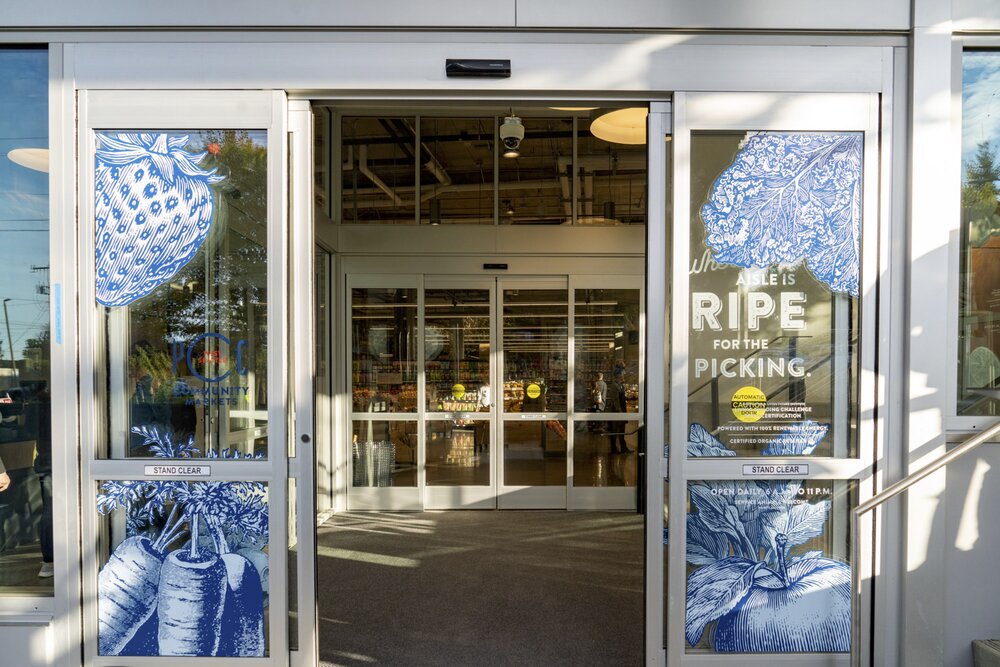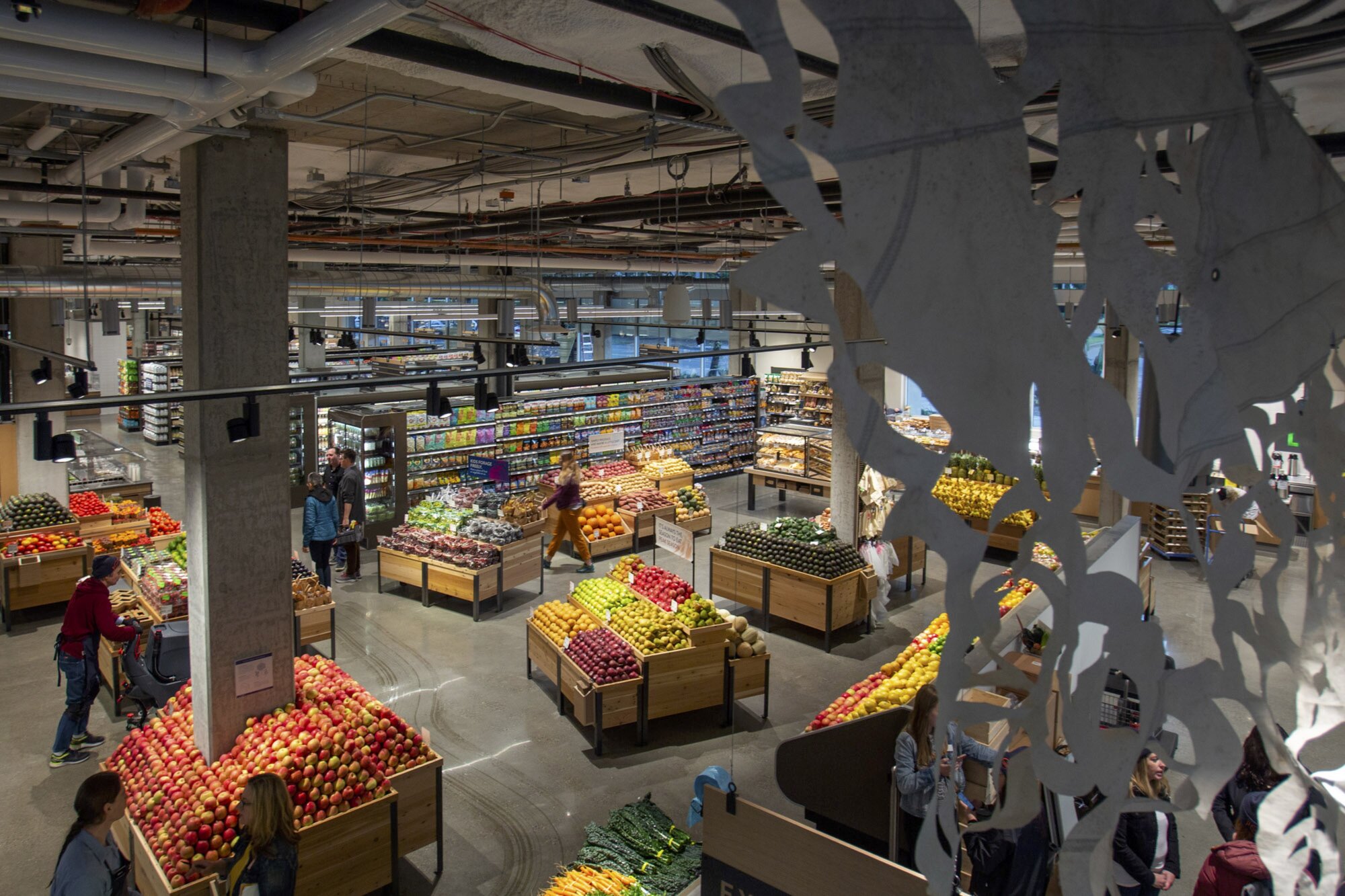Vital Stats
Certification Status
Petal Certified
Version of LBC
3.1
Location
Seattle, WA, USA
Project Area
24,212 square feet
Start of Occupancy
September 2019
Owner Occupied
Yes
Number of Occupants
58
Project Team
Owner
PCC Community Markets
General Contractor
Woodman Construction
Architect
MG2, Graham Baba Architects
Mechanical Engineer
Harris Group
Electrical Consultant
SeaTac Electric
Plumbing Consultant
Williams Mechanical
Lighting Design
SeaTac Electric
Structural Design
Quantum
Food Service Design
Bargreen Ellingson & Smith & Greene
Environmental Graphics Design
Western Neon
Millwork Design & Fabrication
Silver Star
Refrigeration Consultant
Key Mechanical
Sustainability Consultant
Skanska, Silliker & Partners
Place Petal
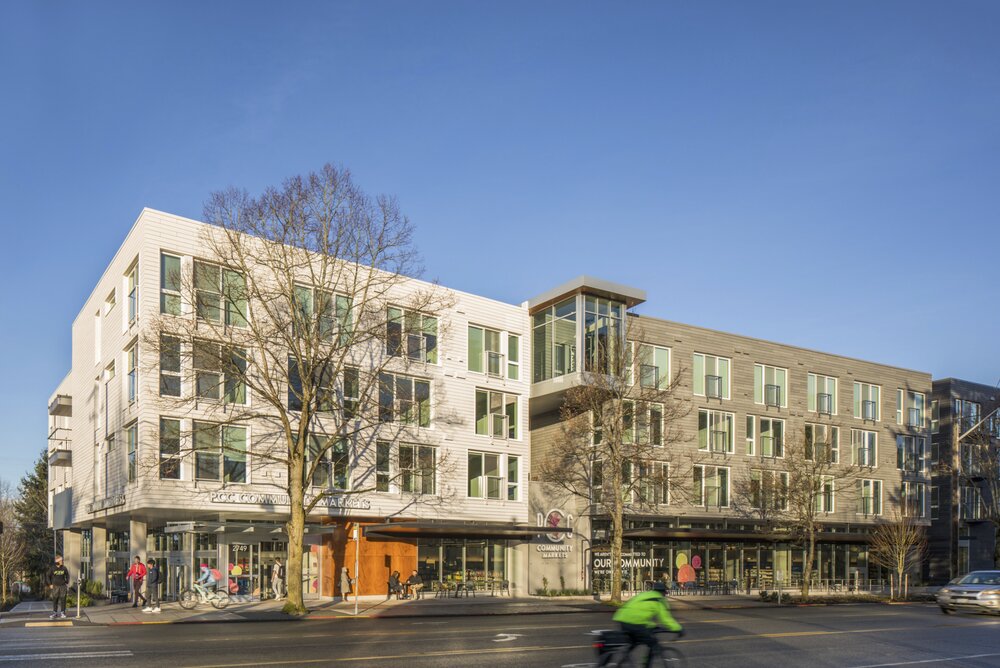
01. Limits to Growth Imperative
The original PCC Community Markets store at West Seattle was built in 1989 at the intersection of California Avenue SW and SW Stevens Street.
History of the Site at West Seattle
West Seattle was settled in 1851 by the Denny Party at Alki Point. Prior to western settlers, the Suquamish and Duwamish lived in the region for hundreds of years in small villages across the sound, thriving on the rich natural resources of the sound. Indigenous artifacts at one West Seattle archeological site date back to the sixth century.
The town of West Seattle grew through the late 1880’s with investments from the West Seattle Land & Investment Company. Ferry service connected the city with Seattle and a cable car took passengers from the water to the town at the top of the hill. In 1904 West Seattle Residents voted to borrow funding to construct an electric streetcar, which ran along the length of California Avenue. In order to gain access to additional infrastructure, residents voted overwhelmingly to be annexed by the City of Seattle in 1907.
West Seattle continued to grow throughout the twentieth century. This growth contributed to a series of transportation challenges as there was limited ferry service and bridges with the main land were few.
The PCC Community Markets site at the intersection of SW California Ave and SW Stevens Street is a part of this rich history. Located specifically in the North Admiral neighborhood, the store is one of many small businesses and restaurants that serve the community. The historic art-deco Admiral Theatre has been showing movies in the neighborhood since 1942. The West Seattle library two blocks away has been open since 1910 and is on the National Register of Historic Places.
Flood Zone and Hydrology of the Site
The project site is located at the top of the West Seattle hill and therefore has little risk of flooding. The 100-yr flood plain remains close to the coasts and low-lying industrial dock terminals.
Site Ecology
The West Seattle site along with the larger Seattle metropolitan region are located in the Temperate Coniferous Forest ecoregion. The lowland forests of the Puget Sound extend across the Olympic Peninsula and north into Canada. The terrain is varied and hilly in the local area but is surrounded by the larger Cascade Mountains. The rich soil formed by glacial material, the mild climate, and the ample rainfall all contribute to the rich biodiversity of vegetation, animal, and sea life, in the region. These conditions have also contributed to a strong farming economy that PCC values and supports in their stores’ product offerings.
Less than a mile to the west of the project site is Schmitz Park, a 53-acre preserve of old growth forest that captures a snapshot of what the whole region would have looked like prior to settlement and development.
The Hiawatha Park across the street from the site is an important community green space for recreation.
02. Urban Agriculture Imperative
PCC Community Markets is a triple bottom line organization, which means that they balance their social, financial, and environmental impact in all decisions that they make. They are dedicated to preserving local farmland and committed to supporting organic agriculture through the products that they sell on their shelves and their growing partnerships with Northwest producers and ranchers. Farmland protection is also part of PCC’s public policy and community giving priorities.
The Washington Farmland Trust was founded by PCC Community Markets in 1999 when they raised the funds necessary to protect Nash’s Organic Produce from impending housing development. They incubated the program with staffing, funding, office space, and employee benefits. Today, the Washington Farmland Trust is a separate 501(c)(3) nonprofit and PCC Community Markets remains its leading business sponsor.
In October 2018, PCC Community Markets announced a $1 million commitment to the Washington Farmland Trust’s Our Farm, Our Future fundraising campaign. In addition, PCC Community Markets partners with the Washington Farmland Trust in a multitude of other ways, from in-store fundraising drives, to PCC Cooks classes. PCC Community Markets recently raised over $30,000 during their in-store “Farmland Forever” drive across their 11 stores.
The Washington Farmland Trust works to protect and steward threatened Washington farmland from the growing pressures of development. To date, the Washington Farmland Trust has conserved 28 farms, totaling over 3,039 acres. Their Our Farm, Our Future fundraising campaign is solely focused on protecting near-urban farmland and has already raised $26 million and counting.
The Washington Farmland Trust protects and conserves farmland when farmers can’t by working directly with landowners to remove their farm’s development potential, or by purchasing at-risk farmland with the goal of leasing or selling it to a local farmer. Tools such as conservation easements are also used to make farmland more affordable.
The Washington Farmland Trust also ensures that protected land thrives for generations through its Farmland Stewardship practices. They continuously monitor physical conditions of protected farmland and supports farmers’ efforts to improve their lands’ water quality, habitat, and soil health. For example, their recently launched micro-grant program, Advancing Farm Sustainability Program, provides the necessary resources and support to farmers who are pursuing more sustainable and organic farming practices.
Lastly, the Washington Farmland Trust also created the Farm to Farmer program, which provides an online and in-person matching and coaching platform to enable new farmers to connect with land opportunities needed to grow their business. It also helps retiring farmers transfer their land to the next generation, ensuring that their land is not lost to development.
The benefits of land protected by the Washington Farmland Trust are shared with their members and shoppers in many ways, including through the products they sell, social media, and their Sound Consumer newspaper.
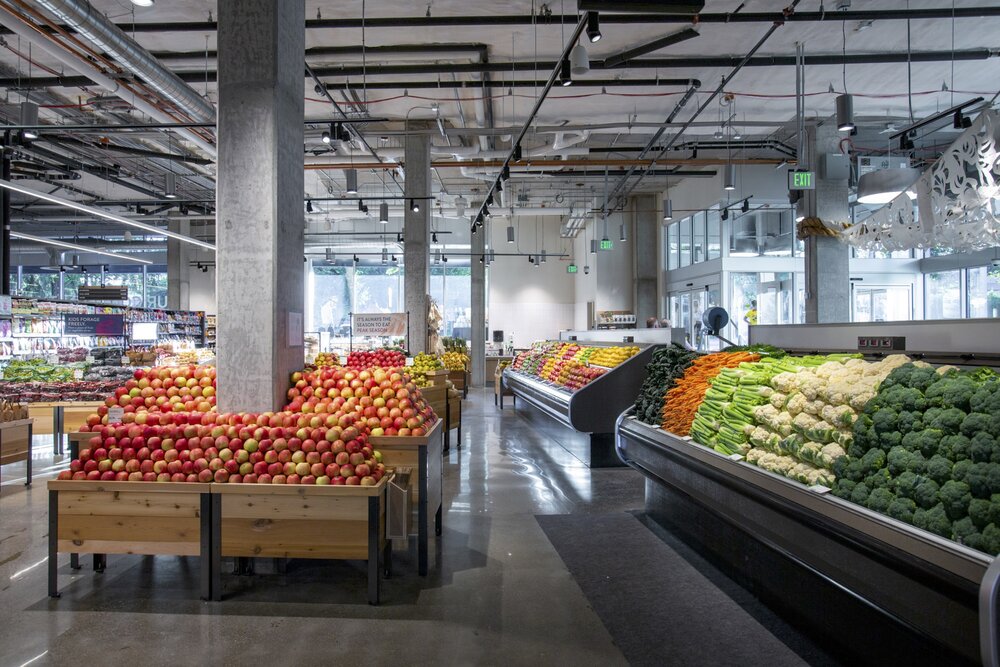
03. Habitat Exchange Imperative
PCC set aside in perpetuity habitat equivalent to the footprint of the project through the Institute’s Living Future Habitat Exchange Program, which aggregates project funds to purchase large tracts of contiguous, high-value, intact ecosystems identified by the Wildlife Conservation Society.
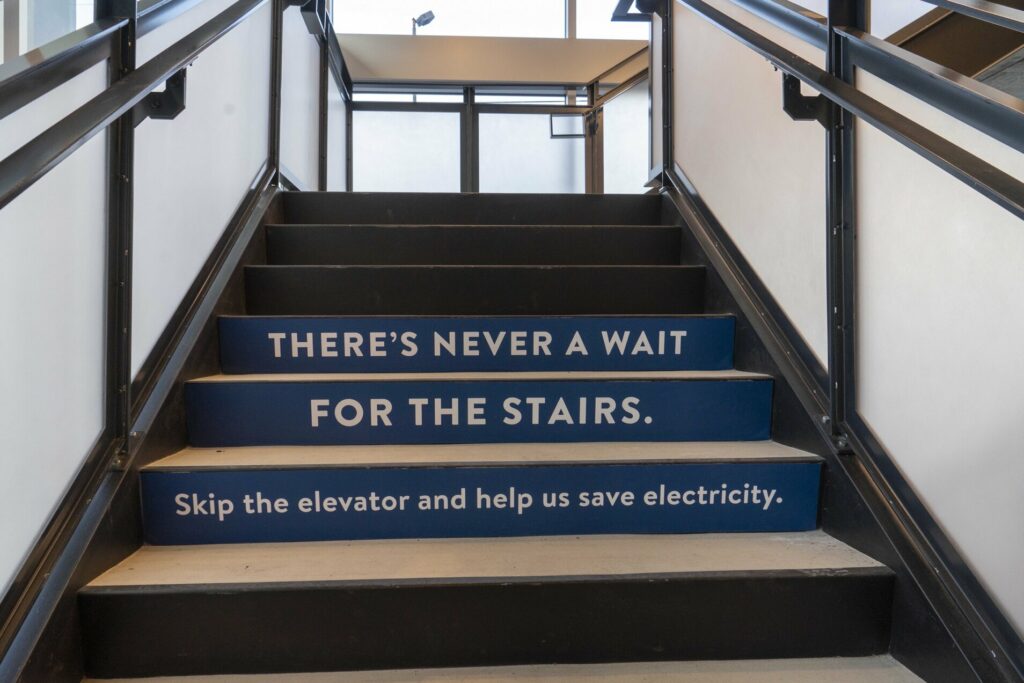
04. Human-Powered Living Imperative
The PCC West Seattle project contributes toward reducing transportation-related environmental impacts and encourages compact, connected communities through increased FAR, supporting a productive lifestyle without the need of a car, and advocating for a human-powered community.
Increased FAR
The new PCC West Seattle store is an Interiors Pathway project, thus the project did not control the FAR decisions made during the design and construction of the core and shell structure. Even so, the project has clearly increased the density from the original condition of the site. The project is built on a site that was an older single-story PCC store. It has occupiable area on multiple levels for a FAR of 1.1, an increase from a FAR of 1.0 prior to the project.
Mobility Plan
The project supports a continued human-powered lifestyle within the building and in the surrounding community. The site is located within blocks of many other residential communities, a school, retailers, gyms, places of worship, other grocers, and medium-density residential buildings, which encourages daily pedestrian community activity. Located on the same block as four bus stops, it is very convenient for people to shop at this store without the need for a car.
This project is an Interiors Pathway, therefore exempt from enhancing pedestrian routes, however, the site was selected for the project in part because of its proximity to public transportation, and residential density nearby which will continue to support the surrounding community via human-powered means. Combined onsite racks provide covered parking for 28 bicycles. Staff also have access to on-site showers and lockers.
Inside the store, a prominent and wide staircase encourages customers and staff to climb stairs instead of using the elevator to reach the seating area and mezzanine level. This design makes the stairs more visible than elevators. Messaging on the stair risers calls out benefits of using the stairs over the elevator.
PCC offers every employee the option of receiving a discounted regional transit pass (ORCA card) that is accepted on regional buses, water taxies, ferries, monorail, rail, light rail, streetcars, vanpools, and vanshares.
Advocacy of Human-Powered Transportation in the Community
An advocacy letter was sent to Washington State Senators and Representatives requesting support for the Washington Wildlife Recreation Program (WWRP) at the $140 million level in the Washington State Recreation Conservation Office’s 2021-2023 capital budget. This letter voiced their support of the Trails, Farmland Preservation, and Riparian Protection categories of the WWRP.
PCC Community Markets is making it easier for shoppers and staff to travel to and from their stores through more sustainable methods of transportation, such as cycling and walking. These efforts require a strong and expansive infrastructure for human-powered transportation options and community health and enjoyment. The WWRP trails grants help to support this infrastructure and help communities improve public health and lower the carbon impacts of transportation by facilitating walking and biking as an alternative to automobile and fossil-fuel-powered transportation. The WWRP is the largest source of trail support in the state of Washington.
Materials Petal
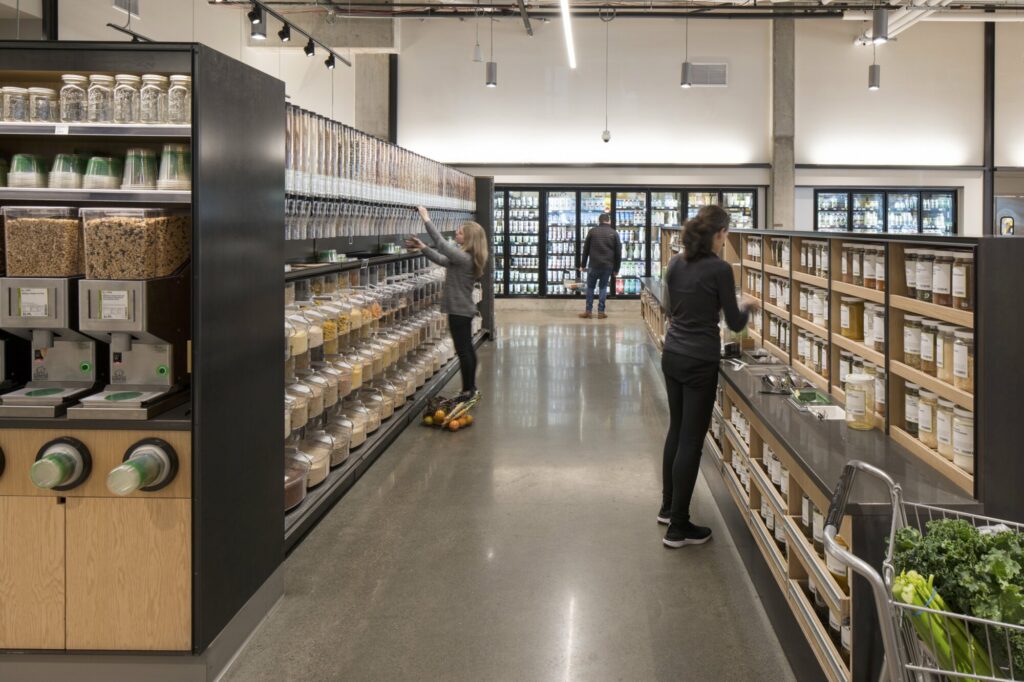
10. Red List Imperative
PCC developed a robust research protocol early in the design process, creating a multi-stakeholder approach to conduct the necessary research and documentation of products used in the project. PCC, the architect, the general contractor, and major system contractors teamed up to contact manufacturers and document the ingredients of all materials selected. Aside from researching materials and products that are merely suitable for the project, all were researched to the LBC Red List compliance standards.
The team developed email templates and forms to collect information when reaching out to manufacturers, requesting disclosure of known product ingredients and including general information about the LBC Red List and a link to the ILFI webpage for more details. Each construction submittal for interior materials and finishes, structural materials, and MEP products was reviewed to confirm ingredients, sourcing location, and FSC chain-of custody (for wood products). The team vetted ingredients of products down to the CASRN or to a level of specificity between 10,000 ppm and 100 ppm (1%-0.01%). When a manufacturer did not fully disclose ingredients, or the product was found to be non- compliant, at least two other manufacturers were vetted for due-diligence. The team collected documentation demonstrating a genuine effort to exclude Red List products by communicating with manufacturers and advocating for the removal of Red List ingredients in their products in the future.
A priority of the team was to specify as many Declare products as possible, focusing on projects that are regionally appropriate, low-carbon, durable, non-toxic, and cost-effective. If no products were found to both comply with the Red List and meet the project’s performance requirements, the team specified the least toxic version available. The team also requested manufacturers to substitute ingredients or components containing Red List ingredients for non-Red List ingredients or parts.
Materials, manufacturers, pricing, and sourcing data were collected and tracked on a Materials Tracking Table. Documentation of the contents of all materials and products used in the project were organized in a shared location, allowing for continuous updates as the project construction progressed.
If manufacturers either did not disclose ingredients or were non-responsive to the team’s request for product ingredients, an advocacy letter was sent to the manufacturer encouraging them to be more transparent in disclosing their product’s ingredients. If products contained Red List ingredients, a letter was sent to the manufacturer advocating for research and development to remove toxic compounds.
Speciality Equipment Exception
Commercial food service equipment, loading dock equipment, and specialty refrigeration units are specific categories of items that must meet stringent performance requirements and are supplied by a limited number of manufacturers. Many of these items do not comply to the Red List Standard, but are functionally necessary in a retail grocery environment. These items were granted an exception and therefore were not required to be vetted. The team did engage the manufacturers in advocating for the removal of Red List ingredients in the future.
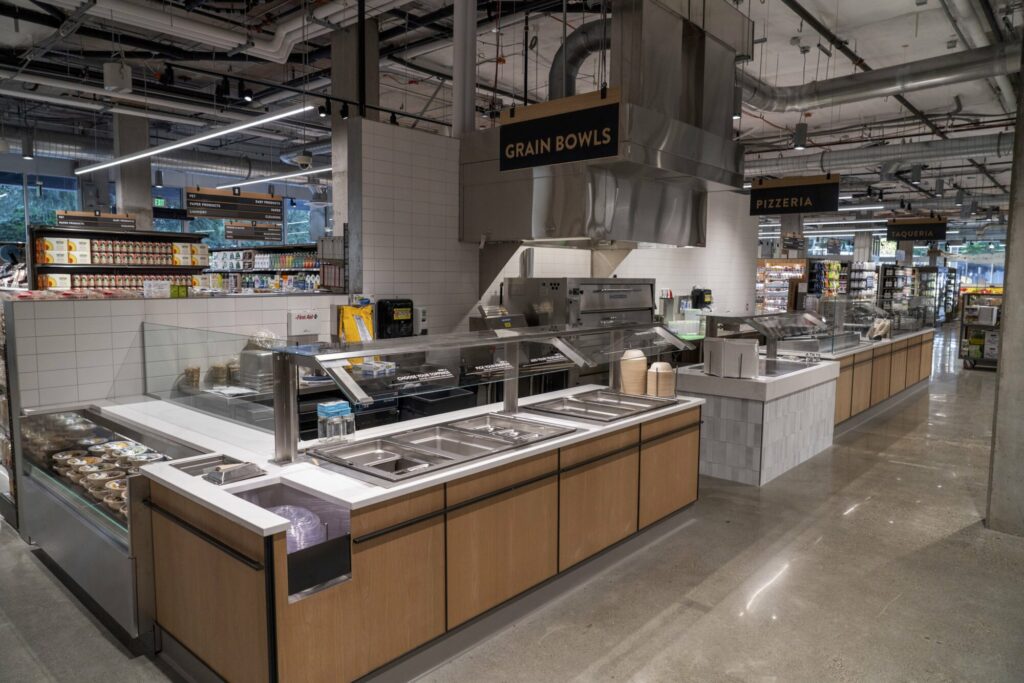
11. Embodied Carbon Footprint
PCC Community Markets examined the embodied carbon of its West Seattle store through several lenses. The analysis for this LBC imperative was done at a building level—essentially the shell that contains their store. While this does provide some context and a rough baseline for their embodied carbon impact, it also illustrates that as a tenant, they do not have influence over the major contributors to this carbon profile— namely, concrete and steel.
Aside from the shell analysis, the team limited the transportation impacts of the products installed in their tenant space. As seen in their Living Economy Sourcing calculations, only 3 percent of their materials budget was manufactured outside of North America. PCC is also dedicated to high quality durable products, which reduces the need to replace items over time.
Additionally, several design choices helped to limit their carbon impact. PCC’s custom casework is predominantly wood-based, which is generally less carbon intensive than metal. And their 100% FSC sourcing supports an important carbon-sink industry. Heavy-gauge steel is limited, and lightweight steel and aluminum is substituted whenever possible. Floors are mostly bare concrete and ceilings are exposed in nearly all areas, limiting the overall material required for their finished space. Materials with recycled content were selected whenever possible.
12. Responsible Industry Imperative
PCC West Seattle utilized two primary lumber pathways—through the casework fabricator and the lumber distributor. Both partners carry their own FSC Chain-of-Custody certification and executed PCC’s requirement to use 100% FSC wood. As such, FSC ensures that forest management operations maintain or enhance the long-term social and economic well being of forest workers and local communities.
The PCC team also conducted advocacy to metal and mineral trade associations, encouraging the development of a third-party standard for sustainable extraction and fair labor practices within their respective industries.
PCC West Seattle incorporates 34 products that have a Declare label, and the team suggested the program to 13 manufacturers that are not currently participating.
13. Living Economy Sourcing Imperative
PCC paid careful attention to specifying and purchasing local and regional products, to reduce long- distance shipping to the project site. The primary goal was to lower the embodied transportation carbon of materials used in the project. The entire design and construction team understood this goal and contributed by investigating manufacturing locations for all products and materials. In particular, PCC’s ties to local fabricators of custom casework and signage is a large piece of its sourcing profile. While much of the project’s kitchen and refrigeration equipment is manufactured outside the Pacific Northwest, the team worked hard to limit its purchases outside of North America to a mere 3% of the project’s materials budget.
In all its materials, finishes, and equipment selections, PCC stands by its dedication to choose durable products that will perform at a high level for a long time, thus reducing the frequency of necessary replacements. Fewer replacements in the future will also reduce carbon emissions from manufacturing and transportation.
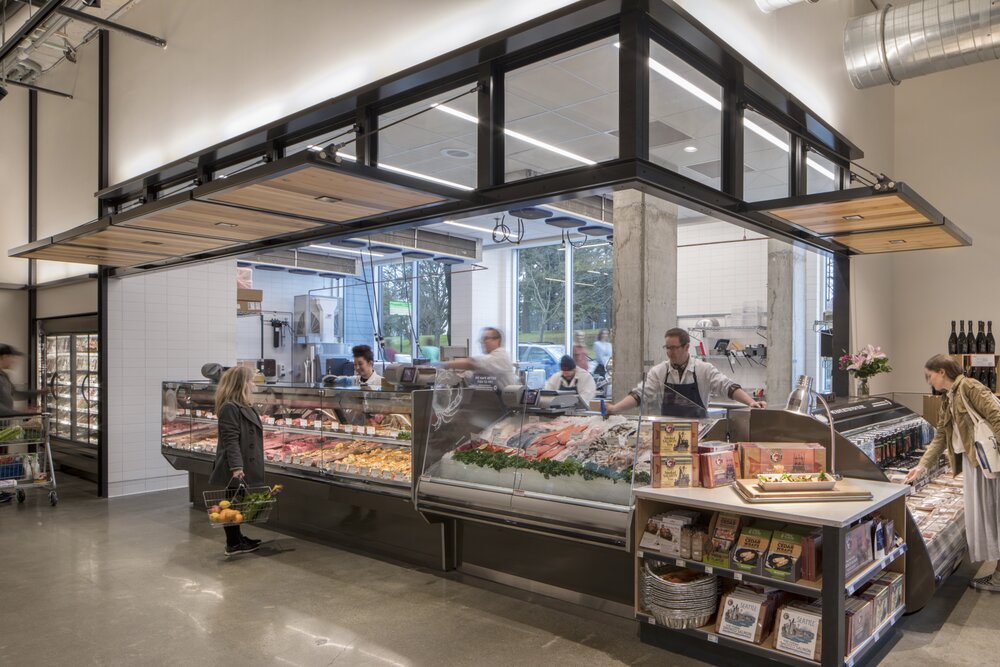
14. Net Positive Waste
PCC reused a variety of items at West Seattle that were salvaged from its other store locations, including wood, plumbing equipment, kitchen equipment, cabinetry, and shelving.
During the construction of PCC West Seattle, the team utilized several bins to sort recycling streams such as metal and wood. The general contractor worked closely with a leading hauler that provided best-in-class commingled recycling services, and also provided photographs and detailed reports of every load.
For many years PCC has incorporated comprehensive recycling and composting infrastructure in stores for employees and customers. In addition to providing well-marked waste bins, PCC offers a line of compostable containers for packaging bulk food and house-made deli items.
Beauty Petal
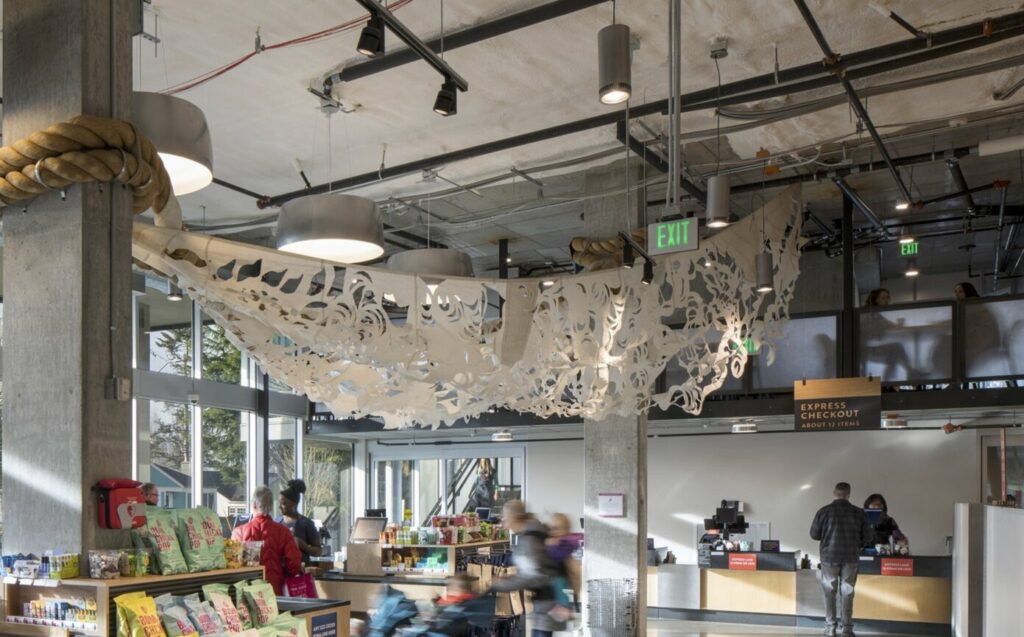
In designing the West Seattle store, the team prioritized daylight and views and how to best celebrate them. Colorful produce departments are located with view to the outdoors and entries. The store layout emphasizes openness and transparency into the work of food preparation as well. Glass clerestories and wood canopies at food prep areas allow daylight into kitchens and are reminiscent of outdoor markets and food halls. Craftsmanship of steel and wood in custom fixtures as well as canopies adds detail in areas of customer interaction. The beauty of natural materials such as wood, stone, tile and concrete are also on display.
West Seattle celebrates its connection to the streetscape. Generous wide sidewalks with street trees and landscaping flank two sides of the store. Large windows bring light and views of nature into the store, and also allow views of store activity to the street side. Pedestrians connect to the staff of the store by observing staff stocking produce tables, cashiers bagging groceries, and butchers and fishmongers at work. Worktables in the meat department face the street and encourage a sense of excitement.
Art Installation
A suspended art installation designed by local artist, Celeste Cooning, is made of reclaimed sail cloth sourced from the Pacific Northwest and vintage natural fiber 15” diameter rope which weighs nine pounds per linear foot. This “cloud wave” harkens to water and creates a canopy effect above the front-end check-out area, extending up to the mezzanine. Pattern, rhythm, and light activate an otherwise static form. The sculpture installation was raised and attached to the columns at 12 to 16 feet high, using ropes and non-mechanical maritime techniques.
“This installation harkens to water as the essential life force, tending to our garden of earthly delights. Pattern, rhythm and light activate an otherwise static form to resonate within our imaginations beyond this transient moment.” – Local artist Celeste Cooning
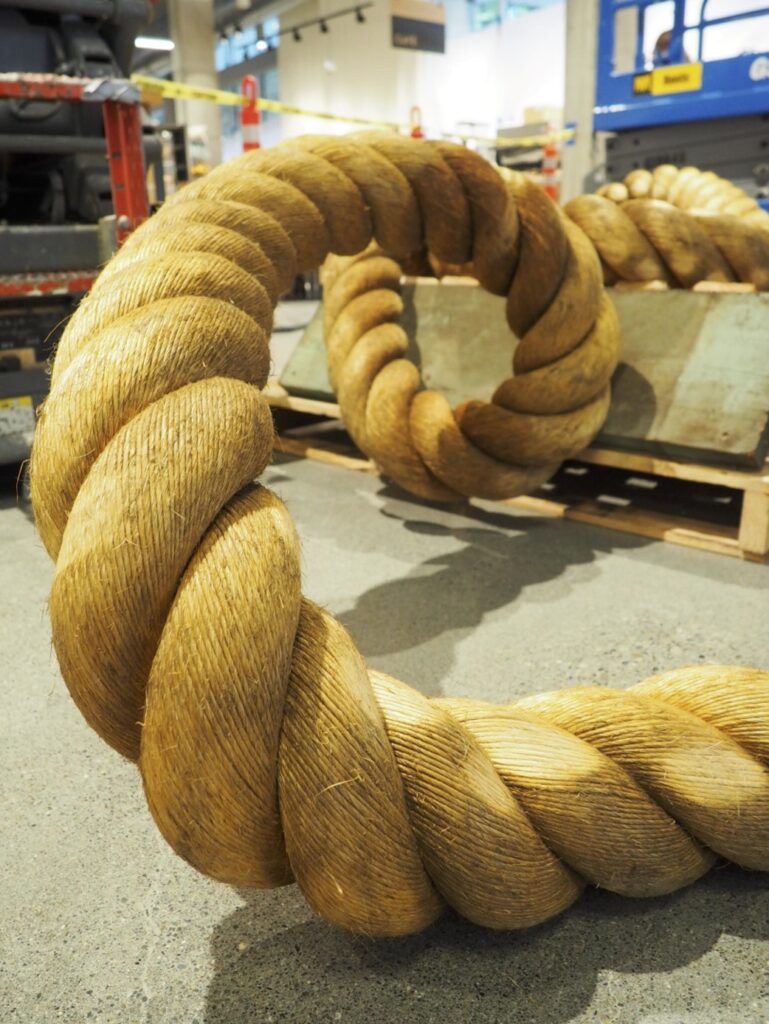
20. Inspiration and Education Imperative
PCC operates on a triple bottom line: financial, social, and environmental considerations are a part of everything they do. In deciding to pursue the Living Building Challenge, PCC strives to apply a similar rigor to the building of their new stores as they do to the products they carry inside their stores.
PCC strives to inspire and educate the public on socially and environmentally sustainable building design by encouraging the public to tour this store. PCC welcomes visitors and shoppers to stop by during operating hours, seven days a week, and learn what it takes for a grocery store to achieve Living Building Challenge Petal Certification.
Free brochures are available in the entrance vestibule for shoppers and visitors who want to learn more about PCC West Seattle’s LBC features. This brochure was designed to accompany interpretive signage that is installed throughout the sales floor, adjacent to examples of various sustainability features. Signage includes detailed diagrams and informative descriptions of what makes the feature more socially and/or environmentally sustainable.
This encourages shoppers and visitors to physically tour the store with the brochure and read each sign
while observing the building feature that it’s next to.
The PCC Living Building Challenge webpage was designed to educate and to be a virtual LBC tour of the store. https://www.pccmarkets.com/living-building-challenge/; https://www.pccmarkets.com/living-building-challenge/west-seattle-lbc/
The public may request a free guided store tour by submitting a request on this webpage: https://www.pccmarkets.com/stores/tours/request/
